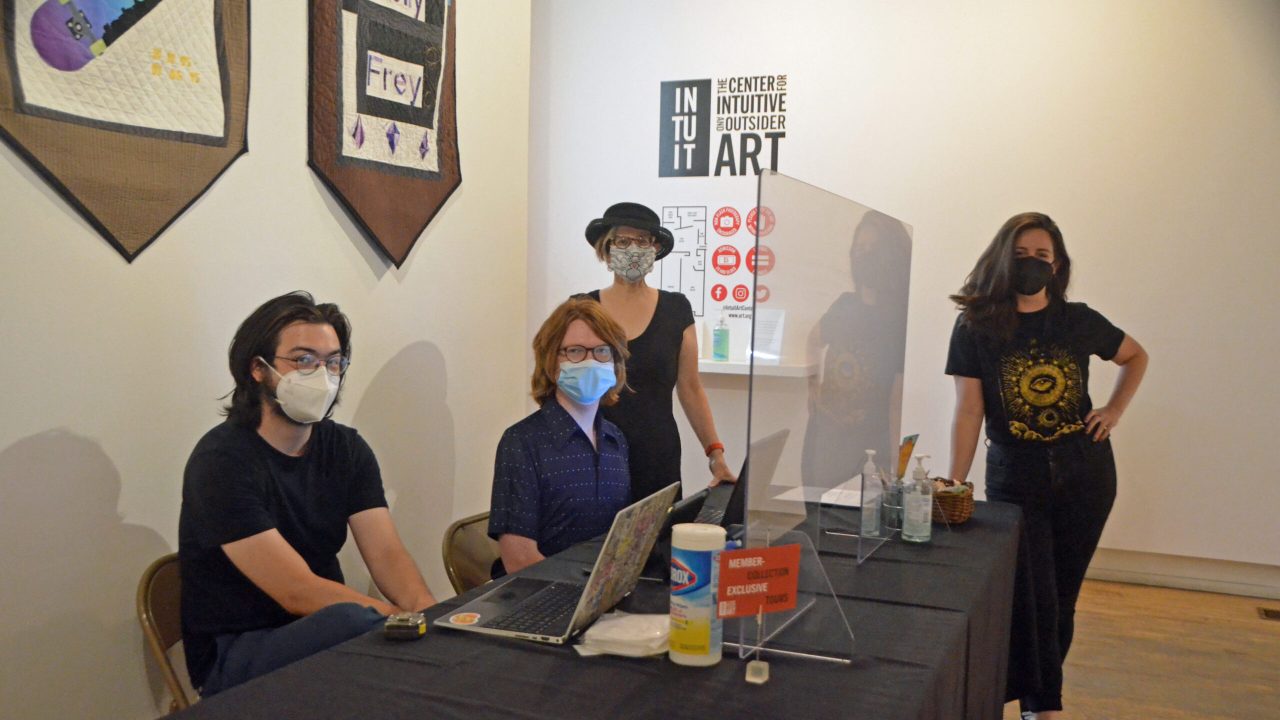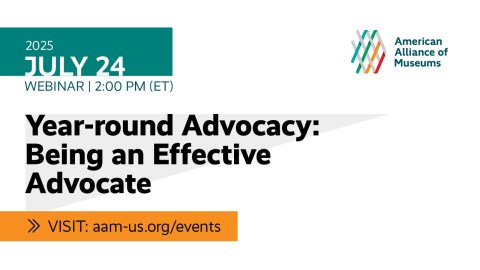
A year ago, I wrote about how Venice is using their pandemic induced pause to rethink how they can create a better future of sustainable tourism rather than rebounding to the status quo of day-tripping hordes. Many museums are using the involuntary lulls of the past year and a half to plan for a better future as well. Last week Allison Titman shared how the Alice Paul Institute is using lessons learned during COVID to create workplace practices that promote gender equity. This week Debra Kerr, president and CEO of Intuit: The Center of Intuitive and Outsider Art in Chicago, tells us how she is integrating pandemic practices into long-term operational change.
— Elizabeth Merritt, Vice President, Strategic Foresight and Founding Director, Center for the Future of Museums, American Alliance of Museums
After telling funders, board members, survey takers, and colleagues for months that the museum community was re-examining its old ways and our museum was never turning back, I was surprised to see the responses to a question posed to small museums on the Museum Junction CEO Community. The question “will some percentage of the work of your staff continue to be remote…?” was answered by five of the first seven responders: 95-100% fully back on site.
Despite the limitations of a small team—or maybe because of the extraordinary creativity required of a small team—my museum, small by art museum standards, is moving forward in 2021 and beyond with no expectations that we must operate in ways that worked prior to 2020. In fact, the COVID era has freed us from the constraints of history and many of the expectations inherent in a board that still has a small percentage of strong founder voices.
Prior to March 2020, full-time staff were on site Monday through Friday, while unpaid volunteers managed the floor. (Weekends included one part-timer to back up the volunteers.) Intuit had no timed ticketing, so most guests were walk-ins. Volunteers would welcome each guest, orient them to the content, and the exhibitions on view, explain the $5 admission price for those older than 18, and take the money for admission and museum store purchases.
No longer. With City of Chicago rules in place, Intuit now uses timed ticketing and ensures guests adhere to current mask and post-travel quarantine mandates. Paid part-time staff (two of whom were former volunteers) were hired to manage the functions formerly handled by front-line volunteers, typically about 12-15 people who filled 2-3 daily shifts. Initially, this was a management decision. The facility coordinator/registrar and I agreed it was unfair to have volunteers policing guests to adhere to procedures that were new to us and visitors. In practice, unlike the conflicts some museums are experiencing with visitors, Intuit’s guests have willingly put on masks, either their own or ones we provide.
I understand small museums may not have the cash to hire part-time staff, and full-time staff may be handling guest admissions. We managed to make it work through two decisions.
- Small Business Administration loans. Intuit received two rounds of Payroll Protection Program loans. We also got an Economic Injury Disaster Loan that must be paid back, but the payback is after 18 months at 2-1/2% interest over 30 years. This is very inexpensive money that is providing a much-needed cash-flow cushion.
- Fewer, better open hours. Before the pandemic, Intuit was open Tuesday through Sunday, with variable hours, depending on the day. Now, we are open Thursday through Sunday, 11 a.m. to 6 p.m. (or by making a special appointment for Tuesdays and Wednesdays). The consolidation of days and hours means we are driving traffic to our busiest days, paying part-time staff on fewer days to manage guests, and delivering a simpler marketing message.
Because full-time staff are no longer expected to provide back-up to volunteers, they can work wherever they choose or need to work—from home or at the museum. Still, it is important to me and our team to maintain our fun and friendly work culture.
All staff, volunteers, and interns are invited to a standing 15-minute Zoom meeting every Monday, Wednesday, and Friday. Attendance at any given meeting is optional, but folks are expected to attend at least once or twice a week. Full-time staff are just this week instituting a once-a-week 30-minute meeting on Tuesday, which will be our regular in-person day on site. Once a month, we have an all-hands IntuiTalk, in which a staff member prepares and presents a single topic, such as completing a condition report, writing a label for guests with blindness, exit survey results for the recent exhibition, and using SharePoint (a web-based collaboration and storage platform). Once a month, we have a Zoom happy hour, which allows interns in other parts of the country to participate. We adopted Slack last summer to facilitate instant messaging across people and teams.
Before the pandemic, we were desperate for desk space. Our offices are in an 800-square-foot lofted space above the exhibition galleries. There is no privacy. When I needed to do an employee performance appraisal, I took the employee out to eat or to a coffee shop. The chief curator and the development manager were literally shoulder to shoulder at one L-shaped desk. Interns and volunteers, sometimes as many as four, sat at the small table in my office area.
Now, instead of having assigned workspaces, we practice “hoteling”—anyone can use any available desk when they need it. We’re slowly buying new computers. We reimburse folks for a portion of their home Wi-Fi and personal cell phones. Our new, money-saving Wi-Fi-based phone system allows us to forward office phones to cell phones, so callers don’t even know staff answering phones may not be in the museum.
One significant downside is the loss of the volunteer corps, many of whom tend to be college students or recent graduates. Although we’ve had interns throughout the pandemic, we didn’t ask the volunteers back last summer for our first re-opening, and they’ve moved on. Only one person is ready to come back. Volunteer recruitment is starting from scratch.
The staff, all along, have been supportive and demonstrated tremendous adaptability. Two folks pointed out that teaching or taking classes is less disruptive from home. Those with a longer commute enjoy the found time. No one liked being fully remote: “I need team members to give me gusto and energy.” And one staff acknowledged the difficulty of managing interns whom she never met in person. But the pros outweigh the cons: “researching and writing,” “making phone calls,” “eating lunch with my husband” and “preparing lunch in my own kitchen,” and “time at home allowed us to adopt a new dog” and “my cat loves having me at home.” Everyone mentioned flexibility. “I can’t image 9 to 5 ever again. It feels rigid. We all understand we are getting work done when we’re at home.”
In June 2020, our marketing person, Annaleigh, announced she was leaving for another position, throwing me into a mild panic. Then, Lindsey, a woman who’d interned for me over two summers, living in Boston while getting her master’s in arts administration, reached out to ask if she would be eligible for the job. I said, “Let’s try you as interim coordinator.” Annaleigh and Lindsey overlapped for a week, creating a smooth transition. After a month, Lindsey and I decided to make it permanent. She just finished her master’s and moved to Chicago, but we would have lost this opportunity in former times.
As for the program side, Intuit is one of only a handful of museums in the world that focuses solely on outsider art. Intuit’s art-making and education programs will continue primarily online (though we hope to get our local Teacher Fellowship Program back in person one day soon), where we reach a national and international audience. We’re taking our small museum creativity and applying it to all our business opportunities and thinking of new models.
In a recent opinion piece for Hyperallergic, Amy Gilman of the Chazen Museum said, “We should not aim to revert to where we were in March 2020. This is the time we can truly change our institutional cultures. Most institutional change tends to be incremental and accumulative, but COVID has provided an unanticipated opportunity. We must ask, ‘How do we want to begin again?’” Although she is focusing primarily on diversity, this is, indeed, a time of unprecedented opportunity for “conscious decision on how we move forward.”
Debra Kerr is president and CEO of Intuit: The Center of Intuitive and Outsider Art in Chicago. Intuit has seven full-time and five part-time staff as of July, up from four full-time and one part-time in 2015. Deb teaches museum management in Northwestern University’s museum certificate program.








